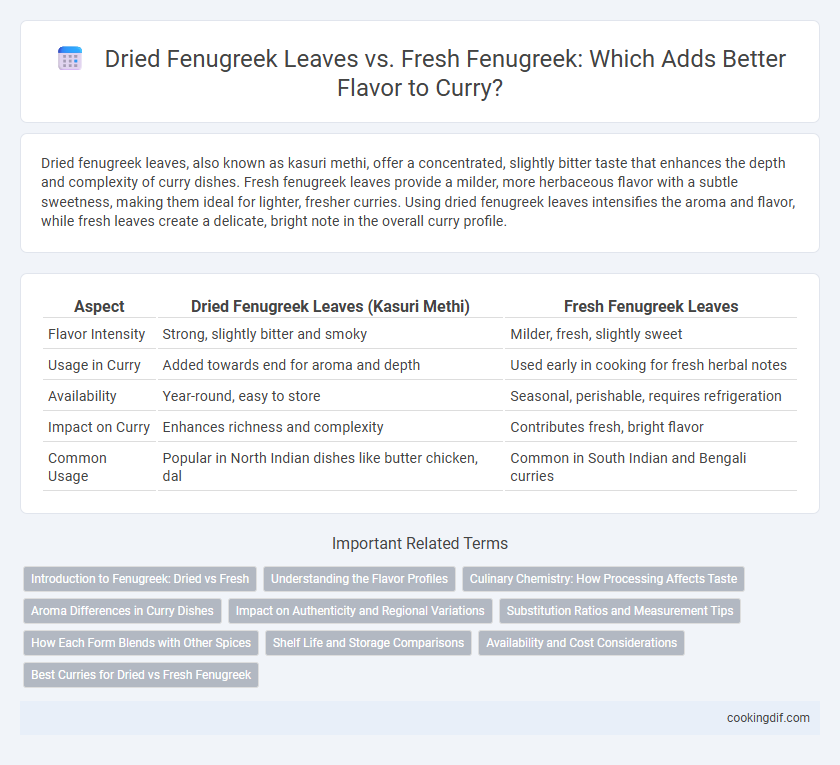Dried fenugreek leaves, also known as kasuri methi, offer a concentrated, slightly bitter taste that enhances the depth and complexity of curry dishes. Fresh fenugreek leaves provide a milder, more herbaceous flavor with a subtle sweetness, making them ideal for lighter, fresher curries. Using dried fenugreek leaves intensifies the aroma and flavor, while fresh leaves create a delicate, bright note in the overall curry profile.
Table of Comparison
| Aspect | Dried Fenugreek Leaves (Kasuri Methi) | Fresh Fenugreek Leaves |
|---|---|---|
| Flavor Intensity | Strong, slightly bitter and smoky | Milder, fresh, slightly sweet |
| Usage in Curry | Added towards end for aroma and depth | Used early in cooking for fresh herbal notes |
| Availability | Year-round, easy to store | Seasonal, perishable, requires refrigeration |
| Impact on Curry | Enhances richness and complexity | Contributes fresh, bright flavor |
| Common Usage | Popular in North Indian dishes like butter chicken, dal | Common in South Indian and Bengali curries |
Introduction to Fenugreek: Dried vs Fresh
Dried fenugreek leaves, also known as kasuri methi, offer a concentrated, slightly bitter flavor ideal for adding depth to curries and enhancing aromatic complexity. Fresh fenugreek leaves provide a milder, greener taste with subtle sweetness, contributing a brightness and freshness to dishes that dried leaves lack. Both forms contain key compounds like sotolon, but the drying process intensifies flavor, making dried fenugreek leaves a powerhouse for traditional curry recipes.
Understanding the Flavor Profiles
Dried fenugreek leaves, also known as kasuri methi, offer a concentrated, slightly bitter, and earthy flavor that intensifies when cooked, making them ideal for rich curries and gravies. Fresh fenugreek leaves provide a milder, slightly sweet, and grassy taste with a hint of bitterness, adding brightness and freshness to dishes like saag or stir-fries. Understanding these distinct flavor profiles helps chefs balance bitterness and aroma to enhance the complexity and depth of Indian curries.
Culinary Chemistry: How Processing Affects Taste
Dried fenugreek leaves concentrate flavor compounds like sotolon, enhancing the characteristic bitter-sweet aroma crucial in curry blends, whereas fresh fenugreek offers a greener, more vegetal taste due to higher moisture and volatile oils. Processing fenugreek through drying reduces water content, intensifies flavor molecules, and stabilizes shelf life, influencing the overall sensory profile of dishes. Understanding this culinary chemistry enables chefs to manipulate fenugreek's taste impact by selecting fresh or dried forms to balance bitterness, aroma, and depth in curry preparation.
Aroma Differences in Curry Dishes
Dried fenugreek leaves offer a more concentrated, slightly bitter aroma that deeply enhances the earthy undertones of curry dishes, while fresh fenugreek imparts a milder, slightly sweet and grassy fragrance. The drying process intensifies the essential oils in fenugreek leaves, contributing to a robust and smoky flavor profile that lingers longer in sauces and gravies. Using fresh fenugreek leaves results in a softer, subtler aroma that blends seamlessly with other herbs but dissipates quickly during cooking.
Impact on Authenticity and Regional Variations
Dried fenugreek leaves, also known as kasuri methi, provide a concentrated, slightly bitter aroma essential for North Indian curries, enhancing authenticity in dishes like butter chicken and dal makhani. Fresh fenugreek leaves offer a milder, grassy flavor preferred in South Indian and Bengali cuisines, where the freshness imparts regional nuances. The choice between dried and fresh fenugreek significantly influences the traditional flavor profile and regional authenticity of the curry.
Substitution Ratios and Measurement Tips
Dried fenugreek leaves are more concentrated in flavor than fresh fenugreek, so use approximately one-third the amount of dried leaves when substituting fresh. For every one tablespoon of fresh fenugreek needed, substitute one teaspoon of dried leaves to maintain balanced taste in curry recipes. Crushing dried leaves before measuring helps release aroma, enhancing the overall curry flavor profile effectively.
How Each Form Blends with Other Spices
Dried fenugreek leaves impart a concentrated, slightly bitter aroma that melds effortlessly with warm spices like cumin, coriander, and turmeric, enhancing curry depth without overpowering. Fresh fenugreek offers a milder, grassy flavor that balances well with vibrant ingredients such as green chili and ginger, adding subtle freshness and complexity. The choice between dried and fresh fenugreek significantly influences the curry's overall spice harmony and flavor layering.
Shelf Life and Storage Comparisons
Dried fenugreek leaves (kasuri methi) offer a longer shelf life of up to one year when stored in an airtight container in a cool, dark place, making them ideal for extended use in curry recipes. Fresh fenugreek leaves provide a more vibrant, slightly bitter flavor but spoil quickly, typically lasting only 1-2 days refrigerated, requiring prompt use for optimal taste. Proper storage of dried fenugreek enhances its aromatic properties over time, while fresh leaves contribute bright herbal notes but demand careful handling to prevent wilting and flavor loss.
Availability and Cost Considerations
Dried fenugreek leaves are widely available year-round and typically more cost-effective than fresh fenugreek, making them a convenient choice for consistent curry flavor. Fresh fenugreek leaves, while offering a vibrant, slightly bitter taste, are seasonal and less accessible in many markets, often leading to higher prices. Choosing between dried and fresh fenugreek depends on budget constraints and the desired intensity of flavor in curry recipes.
Best Curries for Dried vs Fresh Fenugreek
Dried fenugreek leaves, known as kasuri methi, infuse curries like butter chicken and saag paneer with a deep, slightly bitter aroma that intensifies after cooking. Fresh fenugreek leaves offer a bright, slightly grassy flavor ideal for lighter dishes such as methi aloo and stir-fries, maintaining vibrant herbal notes. Using dried fenugreek in slow-cooked curries enhances complexity, while fresh fenugreek works best in quick-cooked recipes to preserve its delicate taste.
Dried Fenugreek Leaves vs Fresh Fenugreek for flavor Infographic

 cookingdif.com
cookingdif.com